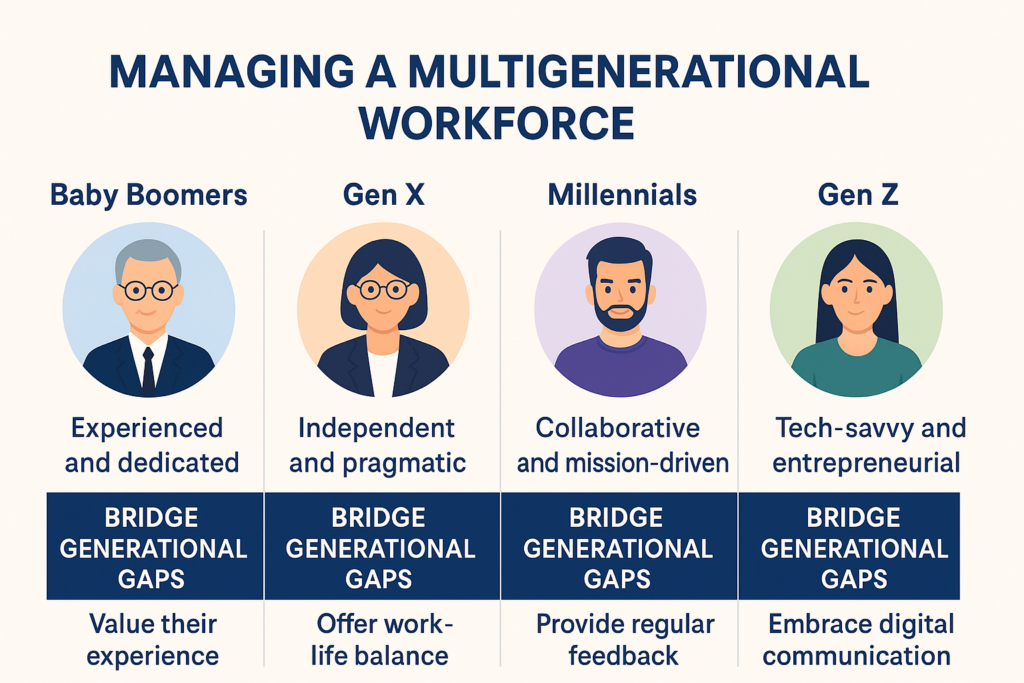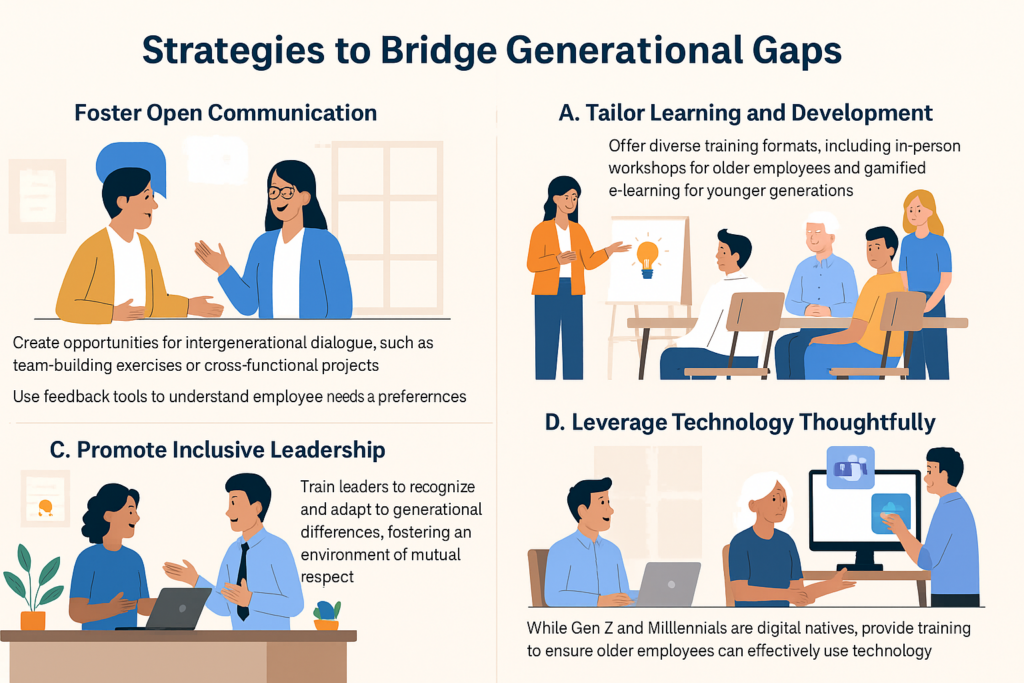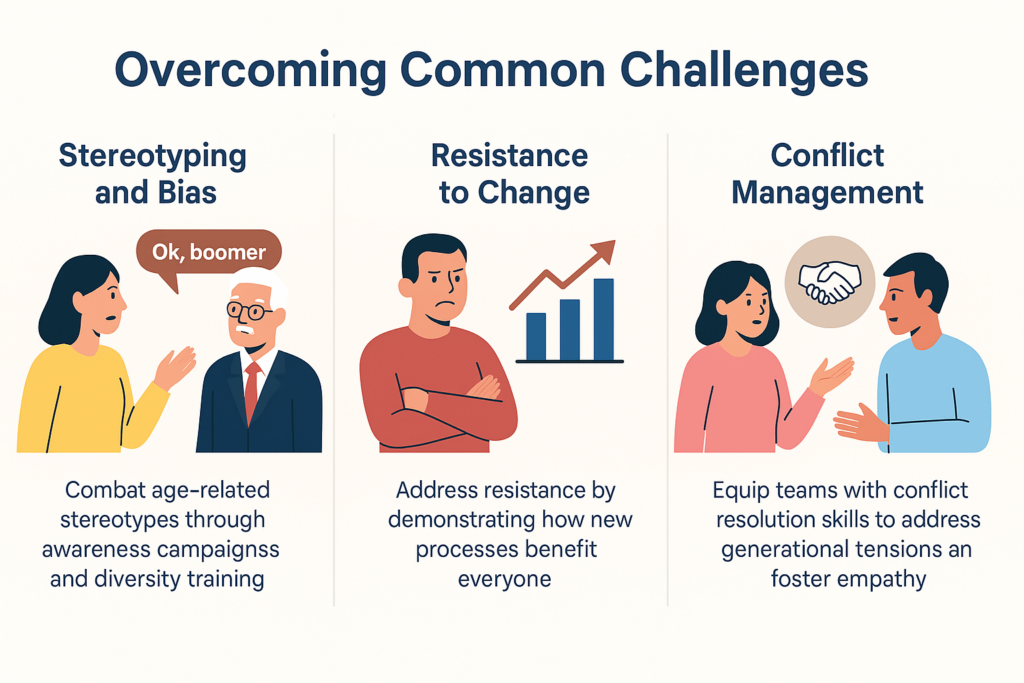The modern workforce is more diverse than ever, with employees spanning: Baby Boomers (1946-1964), Generation X (1965-1980), Millennials (1981-1996), and Generation Z (1997 onward). Each generation brings unique strengths, perspectives, and expectations to the workplace, but managing such diversity can pose challenges. Organizations that effectively bridge generational gaps can unlock innovation, collaboration, and productivity.

-
Understanding Generational Differences
Values and Motivators:
- Traditionalists and Baby Boomers often value stability, loyalty, and recognition for hard work.
- Gen X prefers independence and work-life balance, while Millennials seek purpose, collaboration, and learning opportunities.
- Gen Z, the newest workforce cohort, prioritizes diversity, technology, and mental health.
Communication Preferences:
- Older generations may prefer face-to-face or email communication, while younger ones favor instant messaging, social media, or collaborative platforms.
Stat:
A study by the Society for Human Resource Management (SHRM) found that 35% of workplace conflicts are attributed to generational differences in work styles and communication preferences.
-
Benefits of a Multi-Generational Workforce
-
Diverse Perspectives:
Older employees bring experience and institutional knowledge, while younger ones offer fresh ideas and technological savvy.
-
Increased Innovation:
Collaboration between generations fosters creative problem-solving by combining different skill sets and viewpoints.
-
Knowledge Transfer:
Structured mentorship programs allow older workers to share expertise while younger employees contribute insights on emerging trends.
Example:
IBM’s reverse mentoring program pairs senior executives with younger employees to exchange insights on digital trends and business strategies.
-
Strategies to Bridge Generational Gaps
A. Foster Open Communication
- Create opportunities for intergenerational dialogue, such as team-building exercises or cross-functional projects.
- Use feedback tools to understand employee needs and preferences
B. Tailor Learning and Development
- Offer diverse training formats, including in-person workshops for older employees and gamified e-learning for younger generations.
- Focus on cross-generational learning, such as mentorship and job-shadowing initiatives.
C. Promote Inclusive Leadership
- Train leaders to recognize and adapt to generational differences, fostering an environment of mutual respect.
- Encourage managers to implement flexible policies catering to individual preferences, such as hybrid work schedules or customized career paths.
D. Leverage Technology Thoughtfully
- While Gen Z and Millennials are digital natives, provide training to ensure older employees can effectively use technology.
- Utilize platforms like Slack or Microsoft Teams for communication but ensure inclusivity by accommodating less tech-savvy workers.

Stat:
A 2023 Deloitte survey revealed that organizations that implement inclusive practices for a multi-generational workforce see a 30% increase in team performance.
-
Overcoming Common Challenges
- Stereotyping and Bias: Combat age-related stereotypes (e.g., “Boomers resist change” or “Gen Z lacks commitment”) through awareness campaigns and diversity training.
- Resistance to Change: Address resistance by demonstrating how new processes benefit everyone, using data and success stories to build buy-in.
- Conflict Management: Equip teams with conflict resolution skills to address generational tensions and foster empathy.

Example:
PwC uses intergenerational focus groups to identify potential friction points and collaboratively develop solutions.
-
The Future of Multi-Generational Workplaces
As the workforce evolves, generational diversity will remain a defining feature. Forward-thinking organizations will:
- Emphasize continuous learning to ensure all employees adapt to changing demands.
- Redefine leadership pipelines to be inclusive of younger leaders while valuing older employees’ contributions.
- Create dynamic, adaptable cultures where generational differences are seen as strengths rather than barriers.
Stat:
Research by Gallup shows that organizations embracing generational diversity see a 21% higher profitability rate compared to those that don’t.
Conclusion: Harnessing Generational Strengths
Managing a multi-generational workforce requires more than acknowledging differences—it demands intentional efforts to create an inclusive environment where all employees thrive. By bridging the generational gap through open communication, flexible policies, and tailored development opportunities, organizations can cultivate a harmonious and productive workplace.
In the end, a cohesive multi-generational workforce is not just a competitive advantage—it’s a reflection of a progressive and inclusive organization prepared to meet the challenges of the future.

